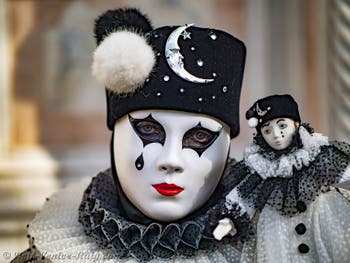History of the Carnival in Venice
The Venice Carnival! A Magic Formula, open Sesame to a Marvelous World of Beauty, Joy and Pleasure
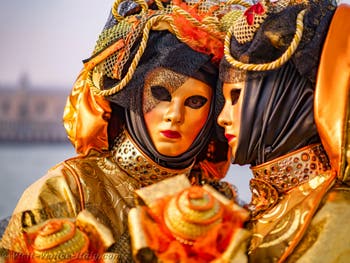
Venice Carnival
“In other states of Europe, the madness of carnival lasts only some days: here they have privilege of extravagance six months of the year.”
Ange Goudar (1708-1791) – translated from L’Espion Chinois
In the 18th century, the Venice carnival began from the first Sunday in October to Christmas, then resumed from Epiphany until midnight on Fat Tuesday, when the bell announced the end of festivities.
It began again in ascent, for two weeks. And it rose from the dead on every election of a new doge, in Saint-Mark or at any opportunity!
The period of carnival opened the season of operas and comedies, and all of Venice waited for new shows with impatience.
For instance, in 1749 Goldoni promised to deliver 16 new comedies for carnival. And the amateurs of the Commedia dell' arte found gratification with Gozzi.
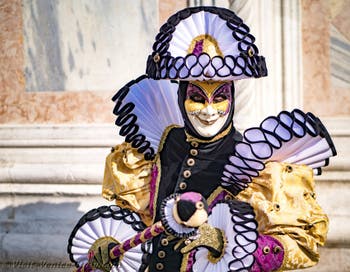
Venice Carnival Albinoni and Vivaldi took responsibility for operas, and the finest vocalists enraptured a public that was very fond of exquisite voices.
Some people were quite expensive: the famous Farinelli asked astronomical prices.
No worries! In Venice, music is a passion, because Venice is the country of music.
The young person Mozart was present at the carnival of 1771.
The beautiful ladies particularly liked to go to the opera, where their fine outfits and glittering jewels were resplendent under the lights of the big chandeliers during this holiday of fashion and elegance.
Added to the jokes and festivities, were the pleasures and danger of debauchery and passion of game!
When the entertainment of the place ends, that of the little room (ridotto) would commence.
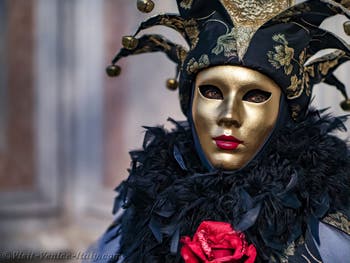
Venice Carnival Ridotto, forefather of the casino, was open every evening and it was accessible to any and all, the only condition was to carry the mask. Under the direction of unmasked noblemen, they played different games: basset, piquet, and especially the Faro.
On the gaming tables huge sums changed hands in a perfect silence in spite of the abundance of losses, and the masks covered the despair of the unlucky ones.
Carnival was the blessed period for the rogues and “hooked” to games such as Casanova and Da Ponte and the ridotto was a place favored for meetings.
Women from all walks of society were under the mask there, with which they could converse, play, flirt and the intermediaries were prompt to be of help, particularly to the rich foreigners!
But beware… the neighboring mask could hide a spy or a jealous husband whose henchmen would follow the audacious as they exited.
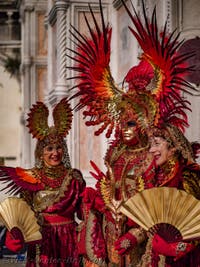
Venice Carnival As jokes and farces of the sort helped to eliminate the worries and small humiliations of the common life, added loving intrigues and discreet meetings became a reality as secret rendezvous.
Because the respect was owed to the mask, all doors opened, including those of palaces and convents, while anonymity was guaranteed.
In History of My Life, Casanova tells how a young patrician moved a beautiful woman away from her cumbersome husband with the complicity of his companions (Casanova was one of them) he managed to get the husband to believe they were Messengers of the Ten coming to arrest him.
They took him away to the island of San Giorgio where he was left, and met at with those who had stayed with the beautiful one!
And everybody spent a entertaining evening…
Here is how Casanova tells about his visit to the convent of Murano under the costume of Pierrot which so allowed him so to meet famed M M., who was the Ambassador of France's mistress:
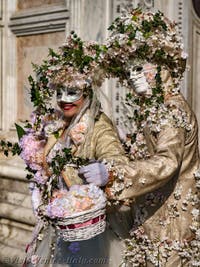
Venice Carnival
“I decided to hide as Pierrot. There is not cleaner mask to dress somebody up if it is not either hunchbacked or lame.
The broad morning coat of Pierrot, its long very broad sleeves, his broad pants which arrive at his heels hide all that he could have of distinctive in all his size so that somebody who would know it particularly should be able to acknowledge it. […]
I go down to the parlor which was full; but everybody makes room for this extraordinary mask, the beings of which nobody in Venice knows.
I get ahead walking like a nincompoop, as the character of the mask demands, and I go to the circle where they danced.
I see Punches, Scaramouch’s, Pantalons, and Harlequins.
I see all nuns at the gates, and every resident, those who sat, others standing, and without stopping my eyes on any, I see however M. M. and standing across the tender C. C. enjoying the show.
Venice Carnival I go around the walking circle as though I had been intoxicated, careful of the head up to feet each; but being much more looked and examined.
Everybody studied me.
I stop on a pretty Harlequin, taking her roughly by the hand to dance a minuet with her.
Each laughs and makes room. Harlequin dances in marvel according to the character of its mask, and me according to mine; I made the biggest pleasure to the company because of the continuous appearance which I had to fall, holding me however always out of balance.
After general fright laughing stock followed.”
Giacomo Casanova
The Grand Hullabaloo
So all possible and thinkable masks circulated across calli or danced on campi, drawn away by the boisterous music of the orchestras composed of flutes, harps, violas, lutes, and of course by "the instrument of the demon", the one who has a dance, the violin!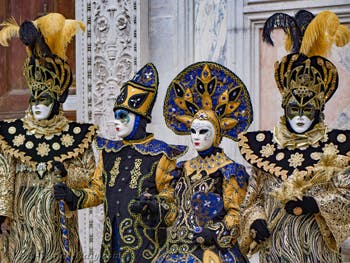
Venice Carnival And everybody walked, and all this flow of colors poured on the Piazza covered with trestles where they displayed marvels, where they sold different things in an ambience of fair.
There are no more days or nights. They slept, ate and drank when they wanted:
“At midnight as in the middle of the day, they find all edibles displayed, all cabarets opened, ready-made suppers in furnished inns and hotels.”
Carlo Goldoni. Memories, I
The time was as jostled as the rest.
More established rhythm, place in fancy, in improvisation and in surprise of meetings! Freedom and anonymity guaranteed by the mask, artistic pleasure doubled by imagination and licentiousness, a catharsis which lasted several weeks and an incredible cosmopolitanism, this is what made the Venetian carnival absolutely unique.
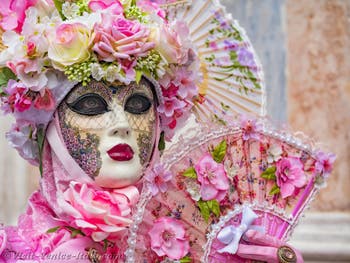
Venice Carnival Under the most complete anonymity, complete fantasies, liberties and nonsense were lawful.
Everybody found their place in this general catharsis, including the homosexuals who were not appreciated in Venice: The young women could disguise themselves as beautiful pages; the men dressed up as women played “Gniaghe” which approached the passers-by by employing evocative and ambiguous purposes, or enjoyed calling out different obscenities to them.
In 1720 Maximilian Misson writes:
“During carnival they push to the limit ordinary profligacy, they refine all pleasures; they plunge up to the throat there.
The entire city is dressed up: vice and virtuousness hide as well as ever.”
Maximilian Misson
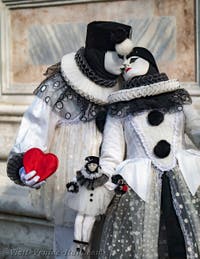
Venice Carnival And he specifies that the place Saint-Mark becomes covered with one thousand kinds of tumblers, masks and musicians and that the courtesans and the foreigners run up by thousands of all corners of Europe.
And the… future Magistrate, Mr. Charles De Brosses explains us that it was not necessary to take up complicated intrigues to arrive at certain goals:
“To end our topic about females, it is necessary here more than elsewhere to say a word about the courtesans.
They compose a really respectable profession, by their good behaviour.
You should not believe, as some says, that their number is so important that you would walk all over them; this happens only in the time of carnival, where you can find under the archways of the Procuraties as many lying down women than standing up ones.”
Charles De Brosses - Written familiar Letters of Italy
On 1739-1740, Carnival had taken such importance, as even a public mourning could not stop it any more.
In 1789, they had held secret the funeral for the doge Paolo Renier!
Mardi Gras, last day of carnival
All these bacchanals attain their fateful paroxysm on Ash Wednesday which marked the beginning of the festivities.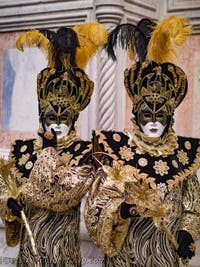
Venice Carnival On Mardi Gras (Shrove Tuesday), they set off fireworks in broad daylight, and in the evening they burn an effigy of carnival: a stake was raised on the piazzetta near columns, and they threw in Carnival which struggles by shouting affronts.
And everything ends with Cavalchina, last masked ball before the Lent and the return to peace. At midnight bells ring to announce the end of festivities.
Zorzi Baffo writes in his Erotic Writings:
“One goes to see the Piazza covered with bankrupt merchants, the hospital filled with people covered with medicated plasters, or with their sex gnawed by ulcer, and the forehead of almost all cuckold husbands adorned with horns.”
And regarding the first day of the Lent he added:
“Oh! What a strange change from evening till morning!
It would seem that a whirlwind confused everything.
All holidays are finished; joy disappeared, as though plague had destroyed everything.
No music, no singing; theatres are closed; dancers and musicians are changed into dormouse.
You could believe in the visit of a magician, who turned the city in a mess.”
Zorzi Baffo
Previous Page: The Mask and Freedom!
Back to Top of Page


